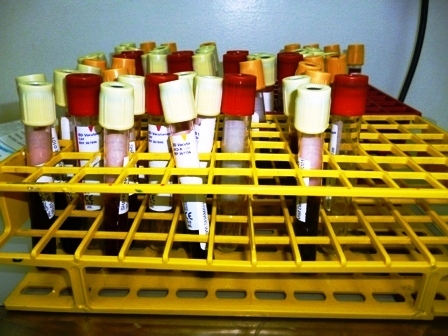User:Shawndouglas/sandbox/sublevel1
Blood serum or serology assays come in three common varieties: LFA, enzyme-linked immunosorbent assay (ELISA), or neutralization assay.[1] As discussed prior, LFAs are intended to be rapid point-of-care tools for qualitatively testing body fluids for patient antibodies or viral antigen. The ELISA is, in contrast, a more lab-bound method which produces results that are qualitative or quantitative. In the context of COVID-19 testing, ELISA tests for the presence of patient antibodies in a given specimen based upon whether or not an interaction is observed with the viral proteins present on the test plate. However, even if antibodies are present, ELISA isn't able to tell a clinician if those antibodies are able to protect against future infection. Neutralization assays are the lengthiest to complete, taking from three upwards to five days.[1] This is largely due to the fact that the assay depends on culturing cells that encourage growth of the target virus. Afterwards, introduced patient antibodies, if present, will fight to prevent viral infection of cells. This process is performed in decreasing concentrations, giving the clinician an opportunity to "visualize and quantify how many antibodies in the patient serum are able to block virus replication."[1] In contrast to ELISA, a neutralization assay is able to determine if a patient's antibodies are actively fighting against the target virus, even after recovering from the infection. In November 2020, the FDA granted an EUA to the first ELISA-based serology test to detect nuetralizing antibodies from recent or prior SARS-CoV-2 infection.[2]
Johns Hopkins' Center for Health Security appears to be tracking serology-based COVID-19 tests that are in development or have been approved in various parts of the globe. However, for the most up-to-date list of serology tests that have received EUAs in the United States, the FDA's EUA list appears to be the best source. As of September 2021, the FDA shows 88 serology assays approved for diagnostic use in the U.S. Of those 88, sixteen are explicitly listed as being ELISA-based.
A review of Johns Hopkins' tracking list showed more LFA-based tests among those approved in other parts of the world. Among their list of those still in development, an LFA stands out for integrating CRISPR detection.[3] CRISPR (clustered regularly interspaced short palindromic repeats) represents bacterial and archaeal DNA sequences derived from DNA fragments of previous infection. This genetic material can then be used as an activator of biomarkers when attached RNA "guides" find a match with target viral RNA in patient specimen.[4] This CRISPR-based LFA, called DETECTR, was further described in a paper published in October 2020, with the authors concluding it could be used "as a complementary technically independent approach to qRT-PCR, thereby increasing the testing capacity of medical microbiological laboratories and relieving the existent PCR-platforms for routine non-SARS-CoV-2 diagnostic testing."[5]
References
- ↑ 1.0 1.1 1.2 Center for Health Security (26 August 2021). "Serology tests for COVID-19". Johns Hopkins University. https://www.centerforhealthsecurity.org/covid-19TestingToolkit/serology/Serology-based-tests-for-COVID-19.html. Retrieved 06 September 2021.
- ↑ Food and Drug Administration (6 November 2020). "Coronavirus (COVID-19) Update: FDA Authorizes First Test that Detects Neutralizing Antibodies from Recent or Prior SARS-CoV-2 Infection". Food and Drug Administration. https://www.fda.gov/news-events/press-announcements/coronavirus-covid-19-update-fda-authorizes-first-test-detects-neutralizing-antibodies-recent-or. Retrieved 18 November 2020.
- ↑ "A protocol for rapid detection of the 2019 novel coronavirus SARS-CoV-2 using CRISPR diagnostics: SARS-CoV-2 DETECTR" (PDF). Mammoth Biosciences. 2 March 2020. https://mammoth.bio/wp-content/uploads/2020/03/Mammoth-Biosciences-A-protocol-for-rapid-detection-of-SARS-CoV-2-using-CRISPR-diagnostics-DETECTR.pdf. Retrieved 09 April 2020.
- ↑ "CRISPR’s powers unleashed for disease detection". Nature - Research Highlights. 16 February 2018. https://www.nature.com/articles/d41586-018-02200-0. Retrieved 09 April 2020.
- ↑ Brandsma, E.; Verhagen, H.J.M.P.; van de Laar, T.J.W. et al. (2020). "Rapid, sensitive and specific SARS coronavirus-2 detection: A multi-center comparison between standard qRT-PCR and CRISPR based DETECTR". The Journal of Infectious Diseases In Print: jiaa641. doi:10.1093/infdis/jiaa641. PMC PMC7665660. PMID 33038252. https://www.ncbi.nlm.nih.gov/pmc/articles/PMC7665660.










